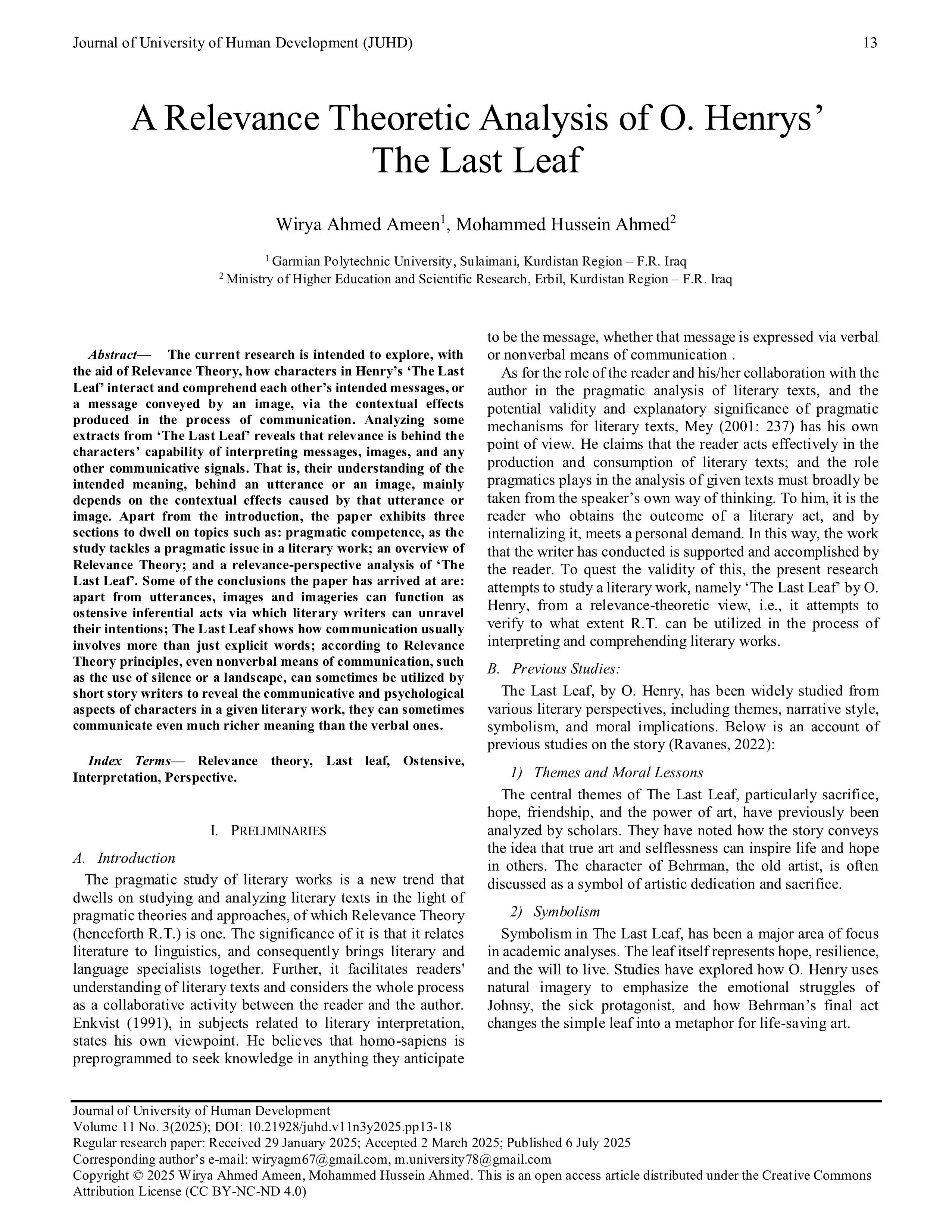A Relevance Theoretic Analysis of O. Henrys’ The Last Leaf
DOI:
https://doi.org/10.21928/juhd.v11n3y2025.pp13-18Keywords:
Relevance theory, Last leaf, Ostensive, Interpretation, PerspectiveAbstract
The current research is intended to explore, with the aid of Relevance Theory, how characters in Henry’s ‘The Last Leaf’ interact and comprehend each other’s intended messages, or a message conveyed by an image, via the contextual effects produced in the process of communication. Analyzing some extracts from ‘The Last Leaf’ reveals that relevance is behind the characters’ capability of interpreting messages, images, and any other communicative signals. That is, their understanding of the intended meaning, behind an utterance or an image, mainly depends on the contextual effects caused by that utterance or image. Apart from the introduction, the paper exhibits three sections to dwell on topics such as: pragmatic competence, as the study tackles a pragmatic issue in a literary work; an overview of Relevance Theory; and a relevance-perspective analysis of ‘The Last Leaf’. Some of the conclusions the paper has arrived at are: apart from utterances, images and imageries can function as ostensive inferential acts via which literary writers can unravel their intentions; The Last Leaf shows how communication usually involves more than just explicit words; according to Relevance Theory principles, even nonverbal means of communication, such as the use of silence or a landscape, can sometimes be utilized by short story writers to reveal the communicative and psychological aspects of characters in a given literary work, they can sometimes communicate even much richer meaning than the verbal ones.
References
Balconi, M., & Amenta, S. (2010). From pragmatics to neuro-pragmatics. Neuropsychology of Communication. Springer.
Brown, K. (2006). Relevance theory. In F. Yus (Ed.), Encyclopedia of language and linguistics (2nd ed.). Elsevier.
Cook, V. J., & Newson, M. (1996). Chomsky's universal grammar: An introduction. Wiley-Blackwell.
Enkvist, N. E. (1991). On the interpretability of texts in general and of literary texts in particular. In R. D. Sell (Ed.), Literary pragmatics (pp. 1–25). Routledge.
Hope and sacrifice in the short story “The Last Leaf” by O. Henry. (2024). SAKSAMA: Jurnal Sastra, 6(1), 45–53.
Jia, Y. (2013). A relevance-theoretic analysis of conversational silence. Theory and Practice in Language Studies, 3(11), 2046–2051.
Jaworski, A. (1993). The power of silence: Social and pragmatic perspectives. Sage Publications.
Mey, J. L. (2001). Pragmatics: An introduction. Basil Blackwell.
Mey, J. L. (2006). Literary pragmatics. In K. Brown (Ed.), Encyclopedia of language and linguistics (pp. 255–268). Elsevier.
Pearl, J. E. (2020). The sound of silence. In Concordian: Mediation Services. Kemp House.
Quan, Y. Y. (2015). Analysis of silence in intercultural communication. ICEMET.
Ravanes, D. R. A., Flores, S. L. V., Dingal, D. S., & Diones, L. L. (2022). The Last Leaf: A psychological study of the characters. International Journal of Modern Developments in Engineering and Science, 1(11), 26–31.
Sell, R. D. (1991). Literary pragmatics: An introduction. In R. D. Sell (Ed.), Literary pragmatics (pp. xi–xxiii). Routledge.
Thomas, J. (1983). Cross-cultural pragmatic failure. World Englishes: Critical Concepts in Linguistics, 4, ed. by K. Bolton & B. B. Kachru. Routledge, 2006.
Wilson, D., & Sperber, D. (2004). Relevance theory. In L. R. Horn & G. Ward (Eds.), The handbook of pragmatics (pp. 607–632). Blackwell.

Downloads
Published
How to Cite
Issue
Section
License
Copyright (c) 2025 Wirya Ahmed Ameen, Mohammed Hussein Ahmed

This work is licensed under a Creative Commons Attribution-NonCommercial-NoDerivatives 4.0 International License.


